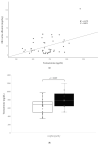Testosterone Levels in Adolescents and Young Men with Type 1 Diabetes and Their Association with Diabetic Nephropathy
- PMID: 34356470
- PMCID: PMC8301039
- DOI: 10.3390/biology10070615
Testosterone Levels in Adolescents and Young Men with Type 1 Diabetes and Their Association with Diabetic Nephropathy
Abstract
The association between serum testosterone levels and type 1 diabetes (T1D), especially in adolescents and young adults, has not been fully investigated. We aimed to compare testosterone levels between adolescents/young men with T1D and controls and to determine the factors affecting testosterone levels. We enrolled 47 men with T1D and 32 controls aged 15-29 years. We evaluated anthropometric measurements, lipid profiles, diabetic complications, and levels of serum luteinizing hormone, follicle-stimulating hormone, hemoglobin A1c, 24-h urine albumin, insulin autoantibody, and total serum testosterone. We assessed the correlation between serum testosterone levels and clinical characteristics. Total testosterone levels were higher in T1D patients than in controls (694.6 ± 182.2 vs. 554.1 ± 147.3 ng/dL, p = 0.001), and 24-h urine albumin level positively correlated with total testosterone levels (correlation coefficient 0.415, p = 0.004). T1D patients with nephropathy showed higher total testosterone levels than those without nephropathy (778.4 ± 198.9 vs. 655.4 ± 162.5 ng/dL, p = 0.029). However, diabetic nephropathy and testosterone levels were not significantly associated after adjusting for confounders (β ± SE 77.5 ± 55.2, p = 0.169). Further longitudinal studies are imperative to confirm a causal relationship between testosterone levels and T1D.
Keywords: adolescents; diabetes mellitus type 1; diabetic complications; diabetic nephropathy; testosterone.
Conflict of interest statement
The authors declare no conflict of interest.
Figures



References
LinkOut - more resources
Full Text Sources

